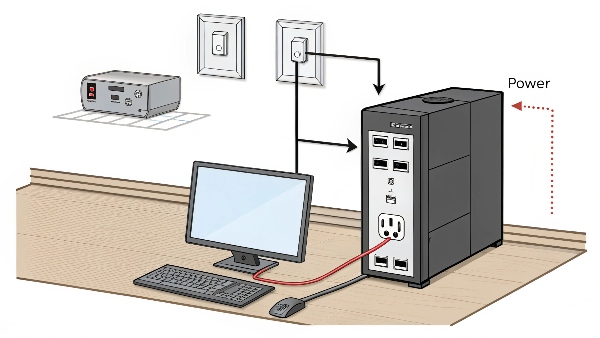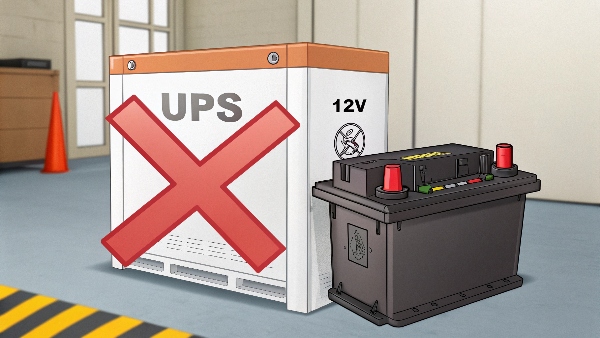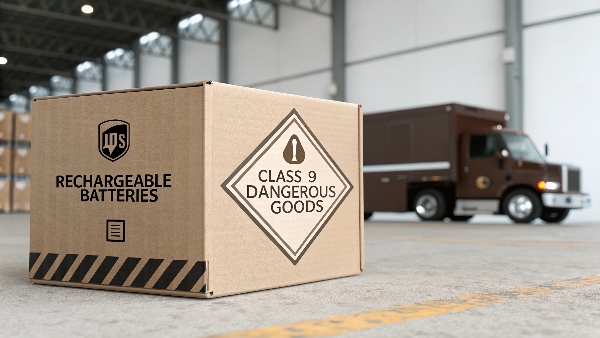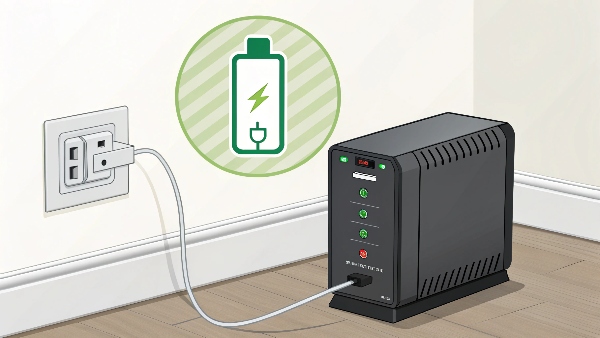Worried about sudden power cuts stopping your important devices? Need a reliable way to keep things running smoothly? These interruptions can be frustrating and even costly.
The most effective way to add backup battery capability to a power supply is by using an Uninterruptible Power Supply (UPS). A UPS is an integrated unit containing a battery, a charger, and power management systems.

As someone who has been deeply involved in designing and manufacturing UPS systems with DAOPULSE for the past ten years, I've encountered this question many times. People often look for complex ways to modify their existing power supplies. The truth is, the solution is usually much simpler and readily available. My core insight here, which I've seen proven time and again, is that uninterruptible power supplies inherently have a charging function, making them the perfect, all-in-one answer for backup power needs. Let's explore this topic and some related questions to understand it better.
Can a computer UPS be used for charging a 12V car battery?
You have a computer UPS. Your car battery is dead. You might think, "Can this UPS help charge my car battery?" It seems like one battery could charge another.
No, a standard computer UPS is not designed or suitable for charging a 12V car battery. Their charging systems and battery specifications are very different, and trying this could damage both.

This is a common thought, but it's important to understand why it's not a good idea. A computer UPS is built to charge and maintain its own internal battery, which is typically a sealed lead-acid (SLA) or lithium-ion type with a specific voltage and capacity. Car batteries are much larger, require higher charging currents, and have different charging profiles. The charger inside a UPS is a low-current charger designed for its specific internal battery, often just a few amps. A car battery, especially when depleted, needs a much higher current, sometimes 10 amps or more, from a dedicated car battery charger. Using a UPS to try and charge a car battery would likely overload the UPS's charging circuit. The UPS isn't designed to output the sustained high current needed. Also, the charging voltages and stages (like bulk, absorption, and float charging) for a car battery are different from what a UPS provides for its internal battery. Attempting this could damage the UPS, the car battery, or both. It’s simply not what a UPS is for. While a UPS provides power from its battery during an outage, its charging circuit is an input feature for its own battery.
| Feature | UPS Internal Battery (Typical SLA) | 12V Car Battery (Typical Lead-Acid) |
|---|---|---|
| Primary Purpose | Backup power for electronics | Starting engine, powering car electrics |
| Capacity (Ah) | Lower (e.g., 7-9 Ah for desktop UPS) | Higher (e.g., 40-70 Ah) |
| Charging Current | Low (e.g., 1-2 Amps) | Higher (e.g., 4-15+ Amps from charger) |
| Charger Design | Integrated, specific to internal battery | External, designed for automotive use |
Can I send rechargeable batteries through UPS (the shipping company)?
You need to ship rechargeable batteries. Maybe it's a replacement for your UPS or batteries for another device. You are worried about the rules for shipping.
Yes, you can usually send rechargeable batteries using UPS (the shipping company). But there are strict rules. Lithium batteries especially are seen as dangerous goods and need special packaging and labels.

Shipping rechargeable batteries, like those found in Uninterruptible Power Supplies or other electronics, involves careful attention to regulations. This is because batteries, if not handled correctly, can pose safety risks like short circuits or fires. UPS (the courier service) and other shipping companies follow international and national guidelines, such as those from IATA (for air transport) and DOT (for ground transport).
For sealed lead-acid (SLA) batteries1, like the non-spillable types often used in UPS systems, shipping is generally less complicated than for lithium batteries. They still need to be packaged securely to prevent any short circuits – meaning terminals must be protected – and to avoid physical damage during transit.
For lithium-ion batteries2, the rules are much stricter. These are classified as Class 9 Dangerous Goods. This means they require specific UN-specification packaging in many cases. The packaging must protect the batteries from short circuits and damage. Often, each battery must be individually protected. You'll need to use special hazard labels. A Shipper's Declaration for Dangerous Goods form might also be required. There are often limits on how many batteries, or their total energy capacity (measured in Watt-hours), can be in one package. Some shipping services (like air freight) might have more restrictions than ground services. At DAOPULSE, we deal with these shipping requirements every day when sending our UPS units and replacement batteries to clients worldwide. It’s a vital part of our service to ensure everything arrives safely and compliantly.
What is the difference between a battery charger and a UPS?
You hear about "battery chargers" and "UPS units." Both manage battery power. But you wonder if they do the same job or if they are different.
A battery charger only puts power back into a battery. A UPS is a full system. It gives backup power, has a battery, and includes its own battery charger plus other features.

It's easy to get these two confused, but they have very different primary roles. A battery charger has one main job: to recharge a battery. It takes AC power from the wall outlet and converts it into DC power at the correct voltage and current to safely replenish a specific type of battery. It doesn't typically power a device directly while charging.
An Uninterruptible Power Supply (UPS), on the other hand, is a more complex system designed to provide continuous, stable power to connected equipment. A key part of a UPS is its internal battery. But it also includes several other critical components:
- An internal battery charger: This is where my insight that uninterruptible power supplies have a charging function comes directly into play. The UPS automatically recharges its own battery when mains power is available.
- An inverter: This converts the battery's DC power back into AC power (for most common UPS types) to run your equipment during an outage.
- A transfer switch: This detects a power loss and quickly switches your equipment from mains power to battery power, often in milliseconds, so there's no interruption.
- Power conditioning: Many UPS units also offer surge protection, voltage regulation, and noise filtering to protect your connected devices from power problems even when there isn't a full outage.
Think of it this way: a battery charger is like a fuel pump at a gas station, designed just to fill up a tank. A UPS is like having a car with its own built-in, self-refilling emergency fuel tank, plus the intelligence to switch to it instantly if the main fuel supply gets cut off, and systems to keep the engine running smoothly.
| Feature | Standalone Battery Charger | Uninterruptible Power Supply (UPS) |
|---|---|---|
| Primary Function | Recharge a battery | Provide backup power to devices |
| Powers Load Directly? | No (generally) | Yes, during outage and often normally |
| Includes Battery? | No (charges external battery) | Yes (internal battery) |
| Charging Capability | Yes (its sole purpose) | Yes (for its internal battery) |
| Transfer Switch? | No | Yes |
| Power Conditioning? | No | Often (surge, regulation, etc.) |
Is it possible to recharge a UPS battery?
Your UPS just kept your computer running during a power blink. You might ask, "Is the battery now empty? Do I need to do something to charge it again?"
Yes, absolutely. A fundamental feature of any UPS is that its internal battery is automatically recharged by the UPS unit itself as soon as mains power is restored.

This automatic recharging capability is precisely what makes a UPS so convenient and reliable. You don't need to manually intervene to charge the battery after a power outage. The UPS handles it all. When the utility power comes back on after an outage, the UPS does two things: it switches your connected equipment back to running on mains power, and it immediately starts using some of that mains power to replenish its internal battery. This ensures the battery is ready for the next potential power disturbance. This is a direct application of my insight that uninterruptible power supplies have a charging function.
The charging circuitry within the UPS is specifically designed for the type of battery it contains, whether it's a traditional Sealed Lead-Acid (SLA) battery or a more modern Lithium-ion battery. This ensures the battery is charged safely and efficiently, which helps to maximize its operational lifespan. Recharge times can vary depending on the size of the UPS, the capacity of its battery, and how much the battery was drained during the outage. Typically, a UPS battery can recharge to about 80-90% of its capacity within a few hours. Through many such charge and discharge cycles, a typical SLA battery in a UPS might last 3-5 years, while lithium-ion batteries can last 8-10 years or even more. As a manufacturer at DAOPULSE, we design these charging systems to be robust and intelligent, ensuring that our clients, like Mr. Li who manages procurement for critical hospital infrastructure, receive UPS solutions that offer dependable, long-lasting battery performance.
Conclusion
Adding backup battery power is best achieved with a UPS. It simplifies everything by including the battery, charger, and automatic switchover, ensuring your devices stay powered without interruption.

